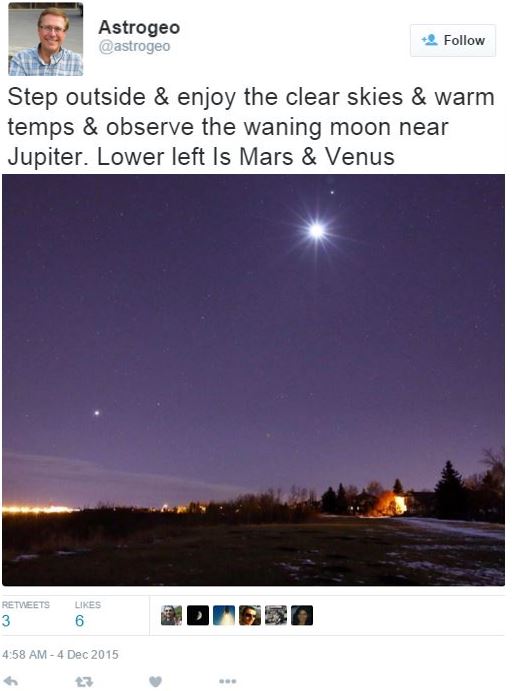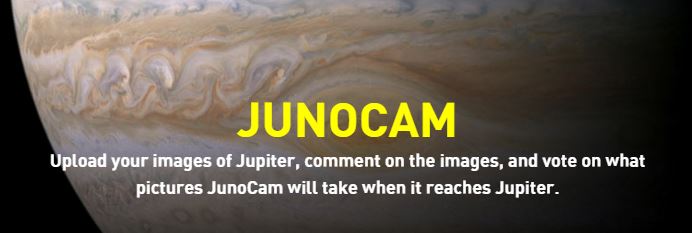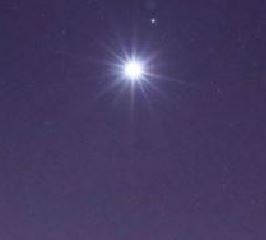If you got up super early on Friday morning you would have seen the Moon and Jupiter providing the night sky with a stunning view. The two celestial objects appeared very close to each other, with the Moon just below Jupiter.
They might have looked as if they were very near each other in the sky, but really they weren’t. The distance from the Moon to Jupiter is about 510 million miles (820 million km). The Space Shuttle, when it was in service, would have taken over three years at its top speed to travel that distance.
As the Moon and Jupiter aligned, stargazers could easily see the waning Moon just 2.5 degrees below Jupiter, our solar system’s biggest planet. Jupiter’s volume is more than 1,300 times that of Earth, i.e. over 1,300 Earths could fit inside it.
 This tweet was posted by Don Hladiuk of the RASC Calgary Centre. (Image: twitter.com/astrogeo)
This tweet was posted by Don Hladiuk of the RASC Calgary Centre. (Image: twitter.com/astrogeo)
If you had looked up at the sky that early morning even with no equipment, i.e. with just the naked eye, you would have spotted the event. If you had a telescope the view would obviously have been much more spectacular.
Several amateur astronomers said they managed to catch a glimpse of Jupiter’s Great Red Spot, a persistent anticyclonic storm, 22° south of giant planet’s equator. Scientists say that the huge storm has a minimum lifetime of 350 years.
People lucky enough to have more powerful equipment may have seen Jupiter’s four Galilean moons – Callisto, Ganymede, Europa and Io. The four moons were discovered by Galileo Galilei (1564-1642), the Italian scientists and philosopher, in 1610. Jupiter has at least 67 moons.
Seeing the Moon and Jupiter so close to each other in the sky is a rare event.
NASA’s Juno mission to Jupiter
NASA’s Juno mission arrives at Jupiter next year on July 4th, when new views of the huge planet’s swirling clouds will be sent back to Earth, thanks to the spacecraft’s colour camera – JunoCam.
However, unlike previous missions into space, professional scientists will not be the ones choosing which images to capture or producing the processed views – members of the public will be Juno’s virtual imaging team, taking part in key steps of the process.
Scott Bolton, Juno principal investigator at the Southwest Research Institute in San Antonio, said:
“This is really the public’s camera. We are hoping students and whole classrooms will get involved and join our team.”
The first stage of JunoCam activity has been started by the Juno team with the launch of a new Web platform on the mission’s website.
 NASA is calling on amateur astronomers to send in pictures of Jupiter they took with their own telescopes. (Image: missionjuno.swri.edu)
NASA is calling on amateur astronomers to send in pictures of Jupiter they took with their own telescopes. (Image: missionjuno.swri.edu)
NASA is calling on amateur astronomers to submit images of Jupiter from their own telescopes. These images will be the basis for online discussions about which of Jupiter’s spots, bands and swirls JunoCam should image as it makes several close passes over the planet.
Candy Hansen, a member of the Juno science team who leads planning for the camera, said:
“In between our close Jupiter flybys, Juno goes far from the planet, and Jupiter will shrink in JunoCam’s field of view to a size too small to be useful for choosing which features to capture. So we really are counting on having help from ground-based observers.”
NASA Goddard Video – Jupiter in 4k Ultra HD
New imagery from the Hubble Space Telescope is revealing details never before seen on Jupiter. High-resolution maps and spinning globes are the first products to come from a program to study the solar system’s outer planets each year using Hubble. The observations are designed to capture as many different features as possible, including winds, clouds, storms and atmospheric chemistry.

